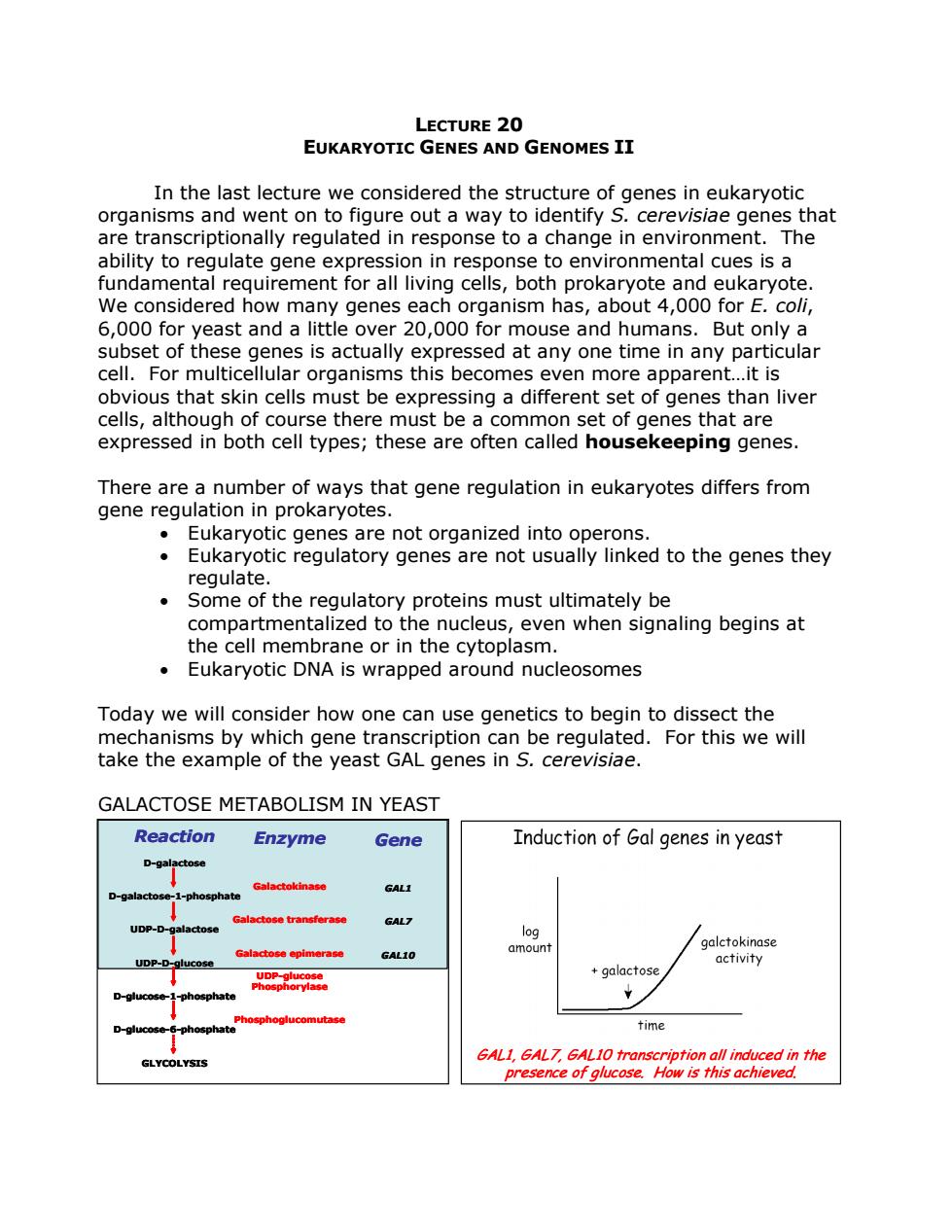
LECTURE 20 EUKARYOTIC GENES AND GENOMES II In the last lecture we considered the structure of genes in eukaryotic organisms and went on to figure out a way to identify S.cerevisiae genes that are transcriptionally regulated in response to a change in environment.The ability to regulate gene expression in response to environmental cues is a fundamental requirement for all living cells,both prokaryote and eukaryote. We considered how many genes each organism has,about 4,000 for E.coli, 6,000 for yeast and a little over 20,000 for mouse and humans.But only a subset of these genes is actually expressed at any one time in any particular cell.For multicellular organisms this becomes even more apparent...it is obvious that skin cells must be expressing a different set of genes than liver cells,although of course there must be a common set of genes that are expressed in both cell types;these are often called housekeeping genes. There are a number of ways that gene regulation in eukaryotes differs from gene regulation in prokaryotes. Eukaryotic genes are not organized into operons. Eukaryotic regulatory genes are not usually linked to the genes they regulate. 。 Some of the regulatory proteins must ultimately be compartmentalized to the nucleus,even when signaling begins at the cell membrane or in the cytoplasm. Eukaryotic DNA is wrapped around nucleosomes Today we will consider how one can use genetics to begin to dissect the mechanisms by which gene transcription can be regulated.For this we will take the example of the yeast GAL genes in S.cerevisiae. GALACTOSE METABOLISM IN YEAST Reaction Enzyme Gene Induction of Gal genes in yeast D-galactose Galactokinase GAL1 D-galactose-1-phosphate Galactose transferase GAL7 UDP-D-galactose log galctokinase Galactose epimerase GAL10 amount UDP-D-glucose activity UDP-glucose galactose Phosphorylase D-glucose-1-phosphate D-glucc time GLYCOLYSIS GAL1,GAL7,GAL10 transcription all induced in the presence of glucose.How is this achieved
LECTURE 20 EUKARYOTIC GENES AND GENOMES II In the last lecture we considered the structure of genes in eukaryotic organisms and went on to figure out a way to identify S. cerevisiae genes that are transcriptionally regulated in response to a change in environment. The ability to regulate gene expression in response to environmental cues is a fundamental requirement for all living cells, both prokaryote and eukaryote. We considered how many genes each organism has, about 4,000 for E. coli, 6,000 for yeast and a little over 20,000 for mouse and humans. But only a subset of these genes is actually expressed at any one time in any particular cell. For multicellular organisms this becomes even more apparent…it is obvious that skin cells must be expressing a different set of genes than liver cells, although of course there must be a common set of genes that are expressed in both cell types; these are often called housekeeping genes. There are a number of ways that gene regulation in eukaryotes differs from gene regulation in prokaryotes. • Eukaryotic genes are not organized into operons. • Eukaryotic regulatory genes are not usually linked to the genes they regulate. • Some of the regulatory proteins must ultimately be compartmentalized to the nucleus, even when signaling begins at the cell membrane or in the cytoplasm. • Eukaryotic DNA is wrapped around nucleosomes Today we will consider how one can use genetics to begin to dissect the mechanisms by which gene transcription can be regulated. For this we will take the example of the yeast GAL genes in S. cerevisiae. GALACTOSE METABOLISM IN YEAST Reaction D-galactose D-galactose-1-phosphate UDP-D-galactose UDP-D-glucose D-glucose-1-phosphate D-glucose-6-phosphate GLYCOLYSIS Enzyme Gene GAL1 GAL7 GAL10 Reaction D-galactose D-galactose-1-phosphate UDP-D-galactose UDP-D-glucose D-glucose-1-phosphate D-glucose-6-phosphate GLYCOLYSIS Enzyme Gene GAL1 GAL7 GAL10 Reaction D-galactose D-galactose-1-phosphate UDP-D-galactose UDP-D-glucose D-glucose-1-phosphate D-glucose-6-phosphate GLYCOLYSIS Enzyme Gene GAL1 GAL7 GAL10 Galactokinase Galactose transferase Galactose epimerase UDP-glucose Phosphorylase Phosphoglucomutase Galactokinase Galactose transferase Galactose epimerase UDP-glucose Phosphorylase Phosphoglucomutase Galactokinase Galactose transferase Galactose epimerase UDP-glucose Phosphorylase Phosphoglucomutase GAL1 encoded GAL1, GAL7, GAL10 transcription all induced in the presence of glucose. How is this achieved. GAL1 encoded GAL1, GAL7, GAL10 transcription all induced in the presence of glucose. How is this achieved

Once a gene has been identified as being inducible under certain inducing conditions,in this case in the presence of galactose,we can begin to dissect the regulatory mechanism by isolating mutants;i.e.,mutants that constitutively express the GAL genes even in the absence of galactose,and mutants that have lost the ability to induce the GAL genes in the presence of galactose.If we were studying galactose regulation today we would probably use a lacZ reporter system as we discussed in the last lecture.However, when the Gal regulatory system was fist genetically dissected,it was done by actually measuring the induction of Gall encoded galactokiase activity,so this is how we will discuss the genetic dissection of the system. Mutagenized GAL1::Tn7lacZ fusion strain grown on: Another approach is to simply measure galactokinase GLYCEROL activity in the presence or absence of Galactose Gal regulatory mutants galactokinase activity -galactose galactose Interpretation Gal+ GLYCEROL GALACTOSE X-Gal +X-Gal Gal1- Gall-inactivates galactokinase Constitutive Gal4- Gal4-is uninducible Gal80- Gal80-is constitutive Uninducible Gal81- + Gal81-is constitutive What we know is that Gal4 mutants are uninducible and that Gal80 and Gal81 mutants constitutively express the Gall galactokinase gene,along with the other Gal genes.Let's analyze each mutant in turn: Gal4 mutant:It was first established that,like Gal1,the Gal4-mutant phenotype is recessive,because heterozygous diploids generated by mating Gal4 to wild type have normal regulation.It was then established that the Analysis of Gal4 mutation in the Gal4-strain lies in a new gene,and not simply in the GAL1 Gal4-is uninducible galactokinase gene;Gall-mutants Gal4+Gal4-is regulated: don't express galactokinase activity in therefore Gal4-is recessive the presence of galactose,just as was MATa Gal1-Gal4+x MATa Gal1+Gal4- seen for the Gal4 mutant.That 1 4 Gal1-and Gal4 mutants have Type1 Type 2 Type 3 mutations in different genes was uninducible uninducible uninducible shown by complementation analysis, uninducible uninducible uninducible (diploids from mating Mata Gal4 uninducible uninducible regulated (wt) uninducible regulated (wt) regulated(wt) with Mata Gal1-behave like wild type)and the fact that the GAL4 and
Once a gene has been identified as being inducible under certain inducing conditions, in this case in the presence of galactose, we can begin to dissect the regulatory mechanism by isolating mutants; i.e., mutants that constitutively express the GAL genes even in the absence of galactose, and mutants that have lost the ability to induce the GAL genes in the presence of galactose. If we were studying galactose regulation today we would probably use a lacZ reporter system as we discussed in the last lecture. However, when the Gal regulatory system was fist genetically dissected, it was done by actually measuring the induction of Gal1 encoded galactokiase activity, so this is how we will discuss the genetic dissection of the system. Another approach is to simply measure galactokinase activity in the presence or absence of Galactose Another approach is to simply measure galactokinase activity in the presence or absence of Galactose GAL1::Tn7lacZ fusion strain grown on: GLYCEROL GLYCEROL + X-Gal GALACTOSE + X-Gal Constitutive Uninducible GAL1::Tn7lacZ fusion strain grown on: GLYCEROL GLYCEROL + X-Gal GALACTOSE + X-Gal GAL1::Tn7lacZ fusion strain grown on: GLYCEROL GLYCEROL + X-Gal GALACTOSE + X-Gal Constitutive Uninducible Mutagenized What we know is that Gal4 mutants are uninducible and that Gal80 and Gal81 mutants constitutively express the Gal1 galactokinase gene, along with the other Gal genes. Let’s analyze each mutant in turn: Gal4 mutant: It was first established that, like Gal1- , the Gal4- mutant phenotype is recessive, because heterozygous diploids generated by mating Gal4- to wild type have normal regulation. It was then established that the mutation in the Gal4- strain lies in a new gene, and not simply in the GAL1 galactokinase gene; Gal1- mutants don’t express galactokinase activity in the presence of galactose, just as was seen for the Gal4- mutant. That Gal1- and Gal4- mutants have mutations in different genes was shown by complementation analysis, (diploids from mating Matα Gal4- with Mata Gal1- behave like wild type) and the fact that the GAL4 and
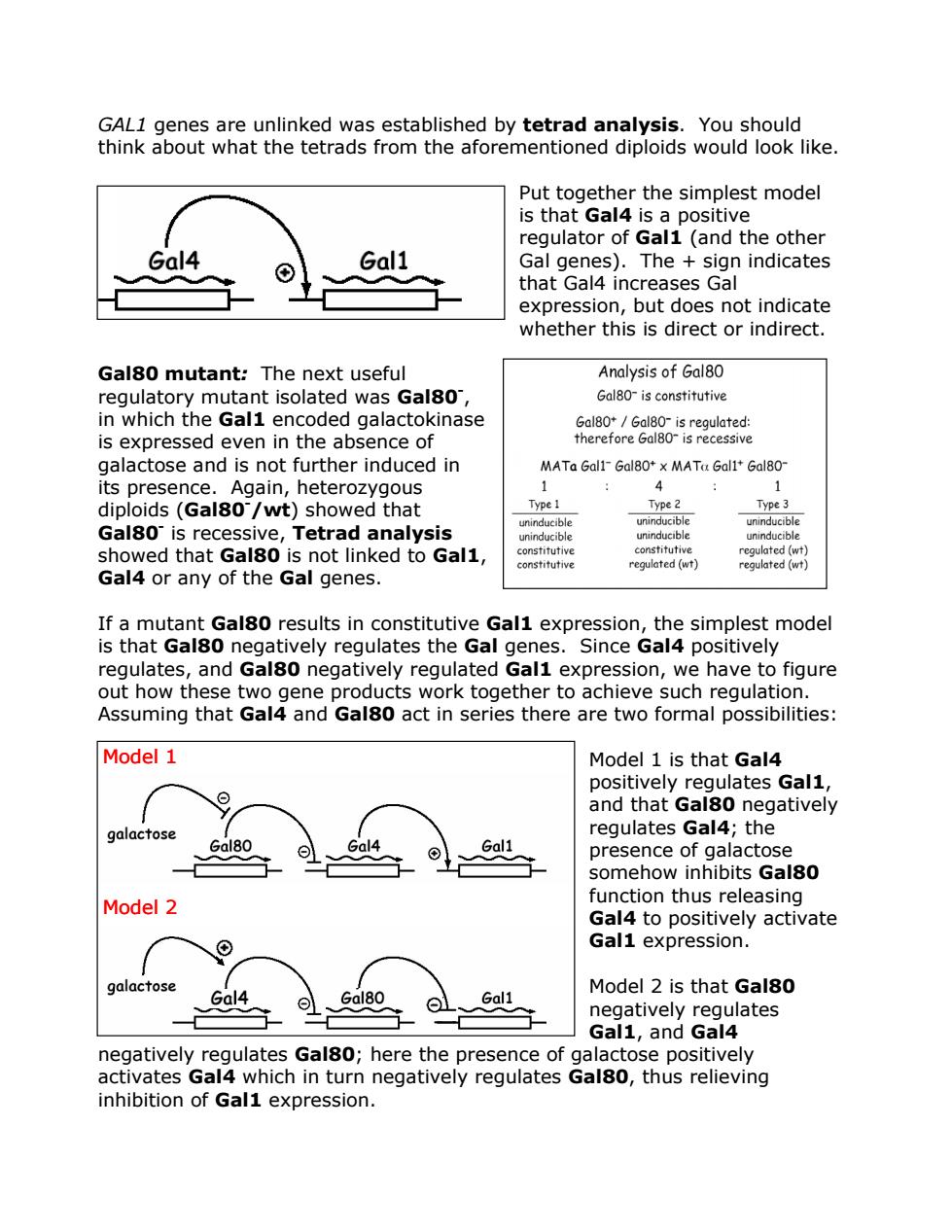
GAL1 genes are unlinked was established by tetrad analysis.You should think about what the tetrads from the aforementioned diploids would look like. Put together the simplest model is that Gal4 is a positive regulator of Gal1 (and the other Gal4 Gal1 Gal genes).The sign indicates that Gal4 increases Gal expression,but does not indicate whether this is direct or indirect. Gal80 mutant:The next useful Analysis of Gal80 regulatory mutant isolated was Gal80, Gal80-is constitutive in which the Gal1 encoded galactokinase Gal80*/Gal80-is regulated: is expressed even in the absence of therefore Gal80-is recessive galactose and is not further induced in MATa Gal1-Gal80+x MATa Gal1+Gal80- its presence.Again,heterozygous 1 4 1 diploids(Gal80/wt)showed that Type 1 Type 2 Type 3 uninducible uninducible uninducible Gal80 is recessive,Tetrad analysis uninducible uninducible uninducible showed that Gal80 is not linked to Gal1, constitutive constitutive regulated(wt) constitutive regulated (wt) regulated (wt) Gal4 or any of the Gal genes. If a mutant Gal80 results in constitutive Gal1 expression,the simplest model is that Gal80 negatively regulates the Gal genes.Since Gal4 positively regulates,and Gal80 negatively regulated Gal1 expression,we have to figure out how these two gene products work together to achieve such regulation. Assuming that Gal4 and Gal80 act in series there are two formal possibilities: Model 1 Model 1 is that Gal4 positively regulates Gal1, and that Gal80 negatively galactose regulates Gal4;the Gal80 Gal4 Gal1 presence of galactose somehow inhibits Gal80 Model 2 function thus releasing Gal4 to positively activate ⊙ Gal1 expression. galactose Model 2 is that Gal80 Gal4 ⊙、 6al80 Gal1 negatively regulates Gal1,and Gal4 negatively regulates Gal80;here the presence of galactose positively activates Gal4 which in turn negatively regulates Gal80,thus relieving inhibition of Gal1 expression
GAL1 genes are unlinked was established by tetrad analysis. You should think about what the tetrads from the aforementioned diploids would look like. Put together the simplest model is that Gal4 is a positive regulator of Gal1 (and the other Gal genes). The + sign indicates that Gal4 increases Gal expression, but does not indicate whether this is direct or indirect. Gal80 mutant: The next useful regulatory mutant isolated was Gal80- , in which the Gal1 encoded galactokinase is expressed even in the absence of galactose and is not further induced in its presence. Again, heterozygous diploids (Gal80- /wt) showed that Gal80- is recessive, Tetrad analysis showed that Gal80 is not linked to Gal1, Gal4 or any of the Gal genes. If a mutant Gal80 results in constitutive Gal1 expression, the simplest model is that Gal80 negatively regulates the Gal genes. Since Gal4 positively regulates, and Gal80 negatively regulated Gal1 expression, we have to figure out how these two gene products work together to achieve such regulation. Assuming that Gal4 and Gal80 act in series there are two formal possibilities: Model 1 is that Gal4 positively regulates Gal1, and that Gal80 negatively regulates Gal4; the presence of galactose somehow inhibits Gal80 function thus releasing Gal4 to positively activate Gal1 expression. Model 2 is that Gal80 negatively regulates Gal1, and Gal4 negatively regulates Gal80; here the presence of galactose positively activates Gal4 which in turn negatively regulates Gal80, thus relieving inhibition of Model 1 Model 2 Model 1 Model 2 Gal1 expression
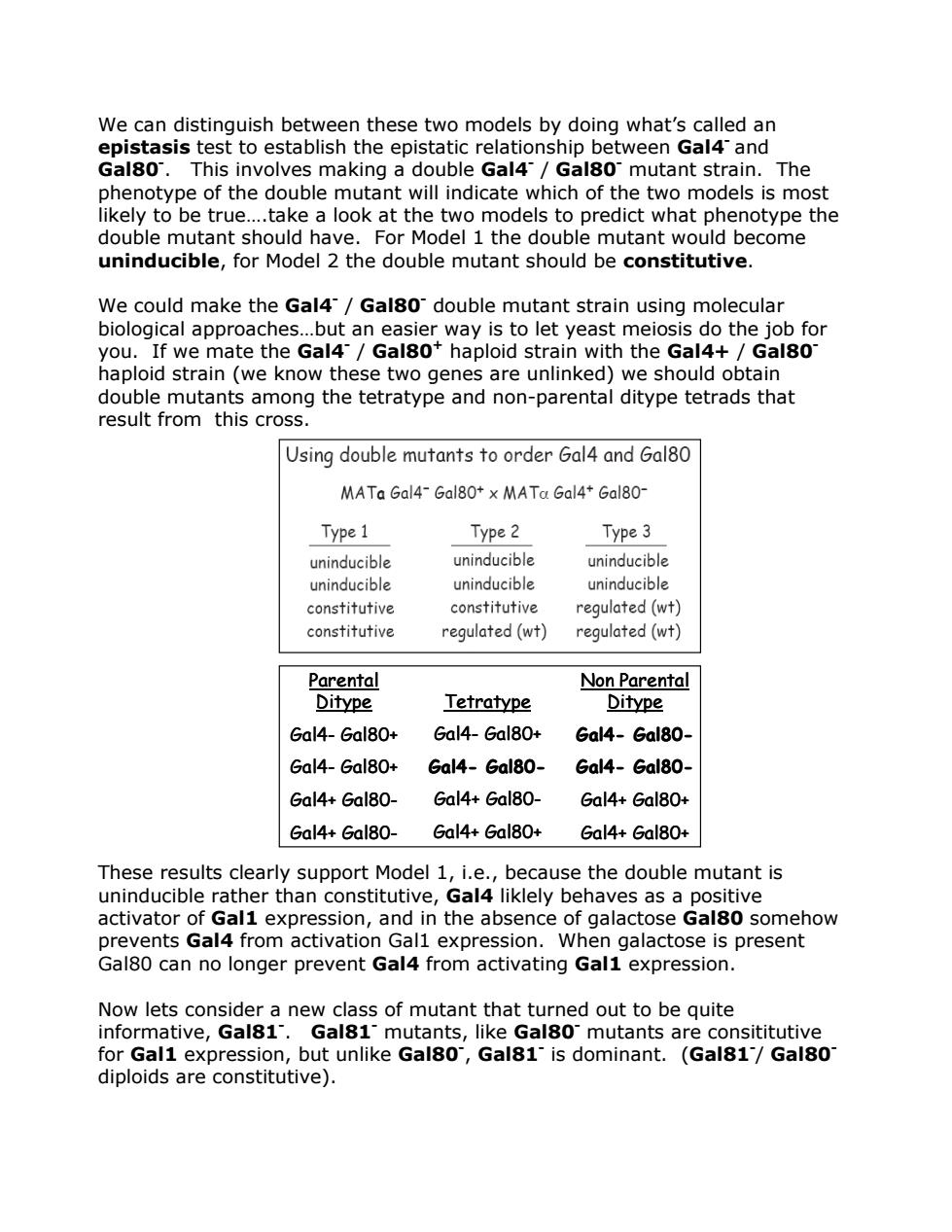
We can distinguish between these two models by doing what's called an epistasis test to establish the epistatic relationship between Gal4 and Gal80.This involves making a double Gal4/Gal80 mutant strain.The phenotype of the double mutant will indicate which of the two models is most likely to be true....take a look at the two models to predict what phenotype the double mutant should have.For Model 1 the double mutant would become uninducible,for Model 2 the double mutant should be constitutive We could make the Gal4/Gal80 double mutant strain using molecular biological approaches...but an easier way is to let yeast meiosis do the job for you.If we mate the Gal4/Gal80+haploid strain with the Gal4+/Gal80 haploid strain (we know these two genes are unlinked)we should obtain double mutants among the tetratype and non-parental ditype tetrads that result from this cross. Using double mutants to order Gal4 and Gal80 MATa Gal4-Gal80+x MATa Gal4+Gal80- Type 1 Type 2 Type 3 uninducible uninducible uninducible uninducible uninducible uninducible constitutive constitutive regulated (wt) constitutive regulated (wt) regulated (wt) Parental Non Parental Ditype Tetratype Ditype Gal4-Gal80+ Gal4-Gal80+ Gal4-Gal80- Gal4-Gal80+ Gal4-Gal80- Gal4-Gal80- Gal4+Gal80- Gal4+Gal80- Gal4+Gal80+ Gal4+Gal80- Gal4+Gal80+ Gal4+Gal80+ These results clearly support Model 1,i.e.,because the double mutant is uninducible rather than constitutive,Gal4 liklely behaves as a positive activator of Gal1 expression,and in the absence of galactose Gal80 somehow prevents Gal4 from activation Gal1 expression.When galactose is present Gal80 can no longer prevent Gal4 from activating Gal1 expression. Now lets consider a new class of mutant that turned out to be quite informative,Gal81.Gal81 mutants,like Gal80 mutants are consititutive for Gal1 expression,but unlike Gal80,Gal81 is dominant.(Gal81/Gal80 diploids are constitutive)
We can distinguish between these two models by doing what’s called an epistasis test to establish the epistatic relationship between Gal4- and Gal80- . This involves making a double Gal4- / Gal80- mutant strain. The phenotype of the double mutant will indicate which of the two models is most likely to be true….take a look at the two models to predict what phenotype the double mutant should have. For Model 1 the double mutant would become uninducible, for Model 2 the double mutant should be constitutive. We could make the Gal4- / Gal80- double mutant strain using molecular biological approaches…but an easier way is to let yeast meiosis do the job for you. If we mate the Gal4- / Gal80+ haploid strain with the Gal4+ / Gal80- haploid strain (we know these two genes are unlinked) we should obtain double mutants among the tetratype and non-parental ditype tetrads that result from this cross. Parental Ditype Gal4- Gal80+ Gal4- Gal80+ Gal4+ Gal80- Gal4+ Gal80- Tetratype Gal4- Gal80+ Gal4- Gal80- Gal4+ Gal80- Gal4+ Gal80+ Non Parental Ditype Gal4- Gal80- Gal4- Gal80- Gal4+ Gal80+ Gal4+ Gal80+ Parental Ditype Gal4- Gal80+ Gal4- Gal80+ Gal4+ Gal80- Gal4+ Gal80- Tetratype Gal4- Gal80+ Gal4- Gal80- Gal4+ Gal80- Gal4+ Gal80+ Non Parental Ditype Gal4- Gal80- Gal4- Gal80- Gal4+ Gal80+ Gal4+ Gal80+ These results clearly support Model 1, i.e., because the double mutant is uninducible rather than constitutive, Gal4 liklely behaves as a positive activator of Gal1 expression, and in the absence of galactose Gal80 somehow prevents Gal4 from activation Gal1 expression. When galactose is present Gal80 can no longer prevent Gal4 from activating Gal1 expression. Now lets consider a new class of mutant that turned out to be quite informative, Gal81- . Gal81- mutants, like Gal80- mutants are consititutive for Gal1 expression, but unlike Gal80- , Gal81- is dominant. (Gal81- / Gal80- diploids are constitutive)
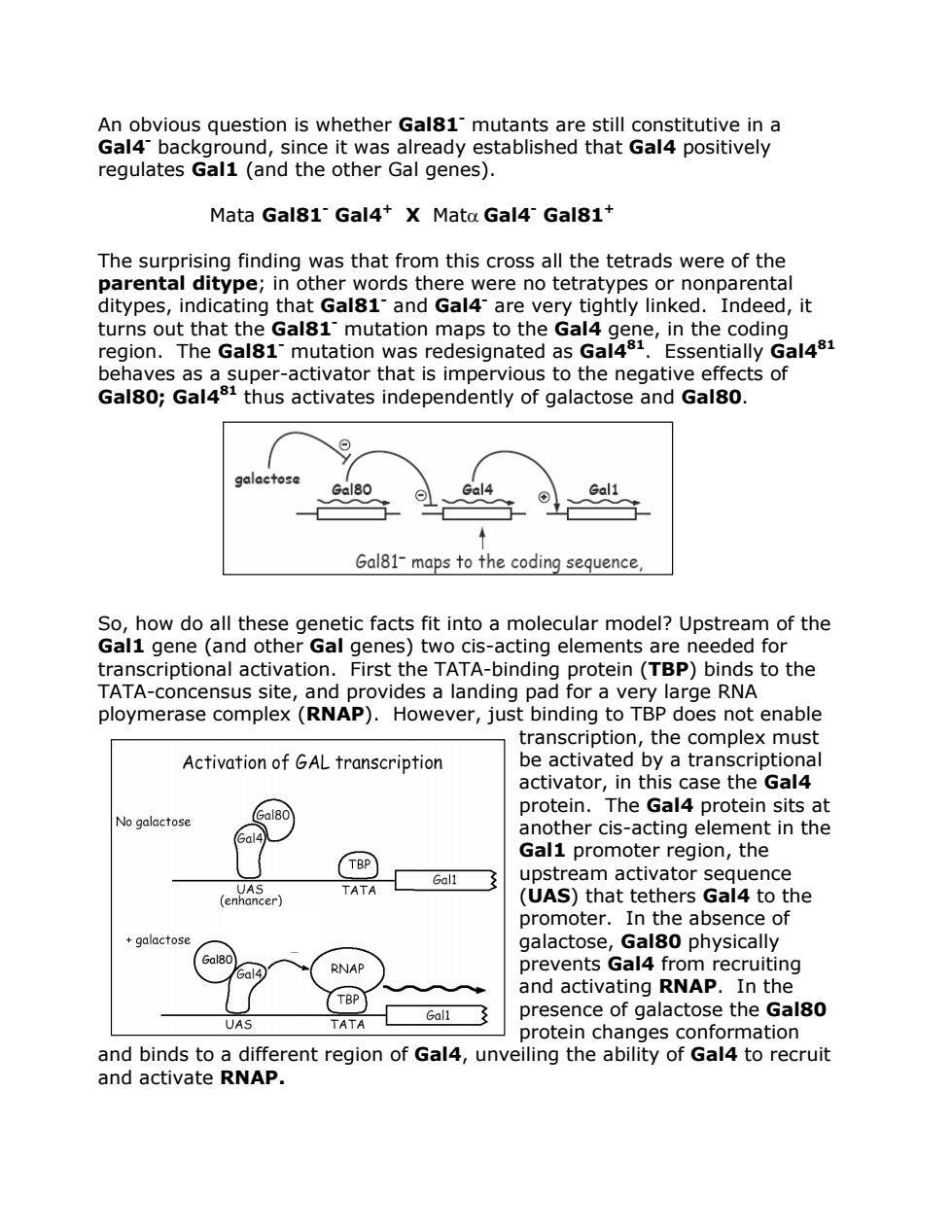
An obvious question is whether Gal81 mutants are still constitutive in a Gal4 background,since it was already established that Gal4 positively regulates Gall (and the other Gal genes). Mata Gal81 Gal4+X Mata Gal4 Gal81+ The surprising finding was that from this cross all the tetrads were of the parental ditype;in other words there were no tetratypes or nonparental ditypes,indicating that Gal81and Gal4 are very tightly linked.Indeed,it turns out that the Gal81-mutation maps to the Gal4 gene,in the coding region.The Gal81"mutation was redesignated as Gal481.Essentially Gal481 behaves as a super-activator that is impervious to the negative effects of Gal80;Gal431 thus activates independently of galactose and Gal80. ⊙ galactose Gal80 Gal4 Gal1 Gal81-maps to the coding sequence, So,how do all these genetic facts fit into a molecular model?Upstream of the Gal1 gene (and other Gal genes)two cis-acting elements are needed for transcriptional activation.First the TATA-binding protein(TBP)binds to the TATA-concensus site,and provides a landing pad for a very large RNA ploymerase complex(RNAP).However,just binding to TBP does not enable transcription,the complex must Activation of GAL transcription be activated by a transcriptional activator,in this case the Gal4 protein.The Gal4 protein sits at No galactose Gal80 another cis-acting element in the Gal1 promoter region,the TBP Gal1 upstream activator sequence UAS TATA (enhancer) (UAS)that tethers Gal4 to the promoter.In the absence of galactose galactose,Gal80 physically Gal80 Gal4 RNAP prevents Gal4 from recruiting and activating RNAP.In the TBP Gal1 presence of galactose the Gal80 UAS TATA protein changes conformation and binds to a different region of Gal4,unveiling the ability of Gal4 to recruit and activate RNAP
An obvious question is whether Gal81- mutants are still constitutive in a Gal4- background, since it was already established that Gal4 positively regulates Gal1 (and the other Gal genes). Mata Gal81- Gal4+ X Matα Gal4- Gal81+ The surprising finding was that from this cross all the tetrads were of the parental ditype; in other words there were no tetratypes or nonparental ditypes, indicating that Gal81- and Gal4- are very tightly linked. Indeed, it turns out that the Gal81- mutation maps to the Gal4 gene, in the coding region. The Gal81- mutation was redesignated as Gal481. Essentially Gal481 behaves as a super-activator that is impervious to the negative effects of Gal80; Gal481 thus activates independently of galactose and Gal80. So, how do all these genetic facts fit into a molecular model? Upstream of the Gal1 gene (and other Gal genes) two cis-acting elements are needed for transcriptional activation. First the TATA-binding protein (TBP) binds to the TATA-concensus site, and provides a landing pad for a very large RNA ploymerase complex (RNAP). However, just binding to TBP does not enable transcription, the complex must be activated by a transcriptional activator, in this case the Gal4 protein. The Gal4 protein sits at another cis-acting element in the Gal1 promoter region, the upstream activator sequence (UAS) that tethers Gal4 to the promoter. In the absence of galactose, Gal80 physically prevents Gal4 from recruiting and activating RNAP. In the presence of galactose the Gal80 protein changes conformation and binds to a different region of Gal4, unveiling the ability of Gal4 to recruit and activate RNAP. Gal80
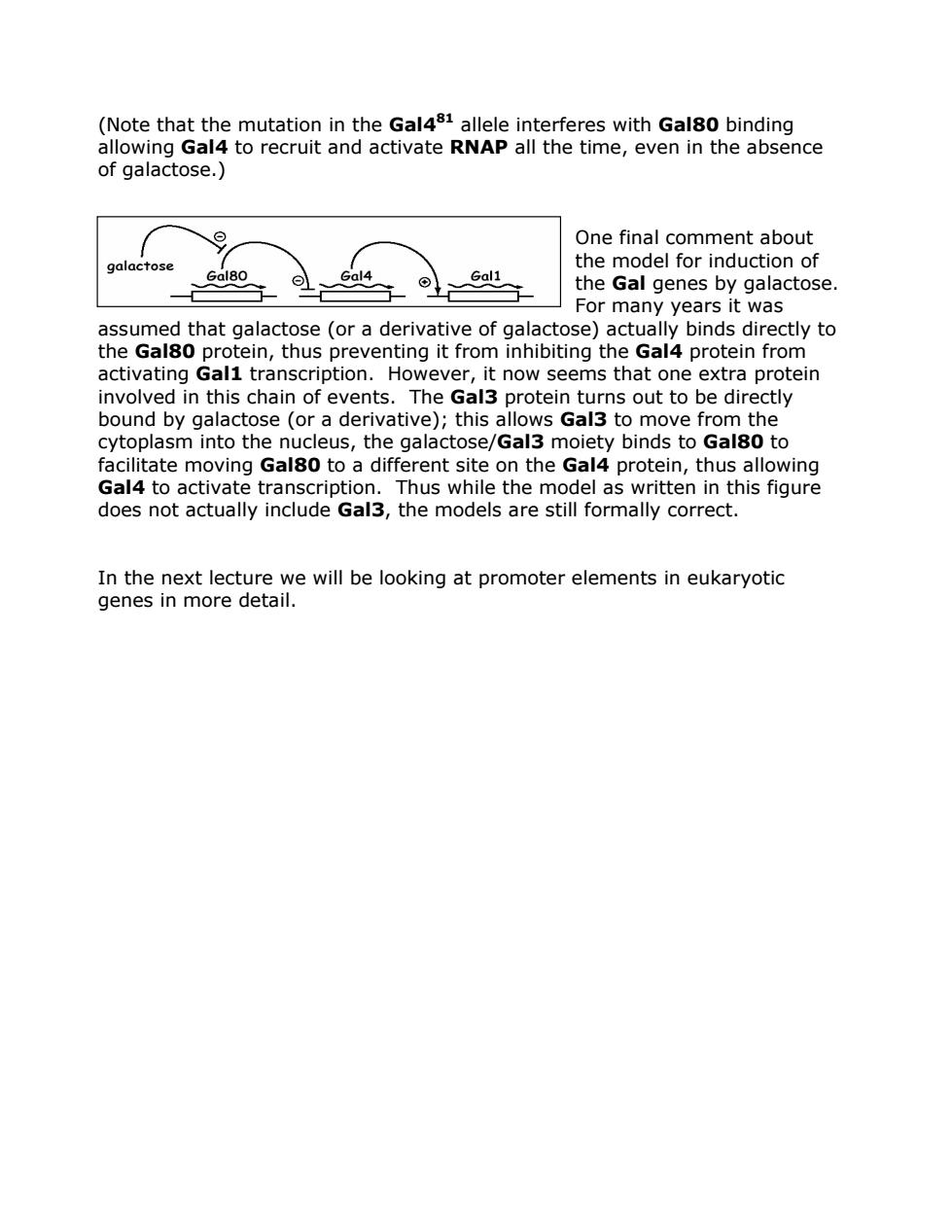
(Note that the mutation in the Gal431 allele interferes with Gal80 binding allowing Gal4 to recruit and activate RNAP all the time,even in the absence of galactose.) ⊙ One final comment about galactose the model for induction of 6al80 Gal4 Gal1 the Gal genes by galactose. For many years it was assumed that galactose (or a derivative of galactose)actually binds directly to the Gal80 protein,thus preventing it from inhibiting the Gal4 protein from activating Gal1 transcription.However,it now seems that one extra protein involved in this chain of events.The Gal3 protein turns out to be directly bound by galactose (or a derivative);this allows Gal3 to move from the cytoplasm into the nucleus,the galactose/Gal3 moiety binds to Gal80 to facilitate moving Gal80 to a different site on the Gal4 protein,thus allowing Gal4 to activate transcription.Thus while the model as written in this figure does not actually include Gal3,the models are still formally correct. In the next lecture we will be looking at promoter elements in eukaryotic genes in more detail
(Note that the mutation in the Gal481 allele interferes with Gal80 binding allowing Gal4 to recruit and activate RNAP all the time, even in the absence of galactose.) One final comment about the model for induction of the Gal genes by galactose. For many years it was assumed that galactose (or a derivative of galactose) actually binds directly to the Gal80 protein, thus preventing it from inhibiting the Gal4 protein from activating Gal1 transcription. However, it now seems that one extra protein involved in this chain of events. The Gal3 protein turns out to be directly bound by galactose (or a derivative); this allows Gal3 to move from the cytoplasm into the nucleus, the galactose/Gal3 moiety binds to Gal80 to facilitate moving Gal80 to a different site on the Gal4 protein, thus allowing Gal4 to activate transcription. Thus while the model as written in this figure does not actually include Gal3, the models are still formally correct. In the next lecture we will be looking at promoter elements in eukaryotic genes in more detail